Home
Services
Online Store
Straightening
Motorcycle
Wheels
Cosmetics
Directions
Shipping
Testimonials
About Us
Quality
Newsletter
Archives
|
|
| was originally developed for steel
wheels around the beginning of the last century. When aluminum alloy
rims began to become popular in the United States, many people tried
to fix them using steel wheel technology. It didn't work and usually
causes even worse damage to the rim. Many people in the auto business
still consider it "common knowledge" that aluminum rims
cannot be straightened once bent, or that bent aluminum wheels can
simply be "hammered out." Neither is true.
|
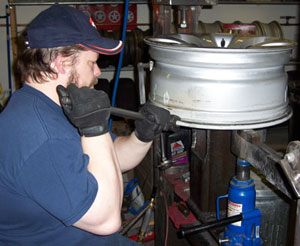 |
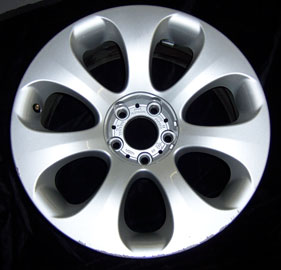 |
Rims get
bent every day by impacts, usually caused by potholes or curbs.
We use our own proprietary technology, which uses heat, hydraulic pressure,
customized tools and metallurgical skill to straighten aluminum
alloy, magnesium or steel rims to factory specifications. Our process
is both an art and a science, requiring literally hundreds of hours
of training before a straightener is qualified to work on ccustomer
rims.
Although several different techniques now exist for straightening
alloy rims, our proprietary process is superior in several ways;
methods that do not use heat, such as "cold roller" technology,
typically leave the affected area weaker than before, while our
technology has a metallurgical effect on the alloy that is similar
to forging steel, strengthening the affected area slightly.
|
Our technology
allows us to straighten rims up to 24" in diameter of
all types and styles. We can often straighten difficult bends
that other straightening technologies cannot, such as center
bent wheels. We straighten all types of auto wheels, including
factory wheels, aftermarket wheels, racing wheels and classic
cars, including Hudson, MG and Triumph wheels.
Here we see the rim to be straightened. The bend can be seen
at the top left, and a closeup is shown below. This is a minor
bend, probably from an impact with a pothole, but still enough
to cause an annoying vibration in the customer's BMW. |
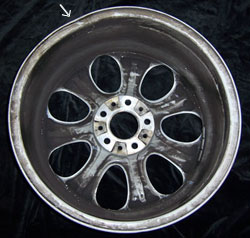 |
|
| 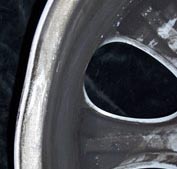
|
It
is almost always easier to bend a rim on the inside, as with
this bend, since there are no spokes to support the rim edge.
This can make the bend difficult to find without removing
each rim and checking the inside edge.
We are fully equipped to take all four rims off your car
and check each rim individually for damage, as well as to
mount and balance the tires after straightening. Checking
all four rims and straightening any that need repair generally
takes 1-2 hours, by appointment, or 1-2 days if the rims are
dropped off. |
|
| We have had customers
drive to us from as far away as Prince Edward Island and New Jersey
to have their rims straightened here, but we think it's much easier
to ship us a rim
for repair if you live that far away! We straighten shipped
wheels within 24-48 hours of receipt and we charge you what UPS
charges us for return shipping.
We can also straighten steel wheels, but we find that
most steel wheels are cheaper to replace than to straighten! It
is our policy to check the replacement cost of steel wheels to ensure
that our customers know what their options are when choosing whether
to straighten or to replace their wheels. |
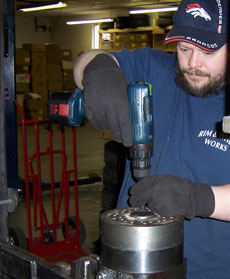 |
 |
Sean, our
Shop Manager, mounts the wheel onto a specially designed plate which
replicates the bolt pattern of the BMW the rim came from. This allows
the wheel to spin perfectly centered on our machine.
The wheel is then "read out" using a dial indicator,
showing the straightener exactly where it is bent and by how much. |
| The wheel is marked
to indicate the exact location of the bend. Not all wheels are as
simple as this one; some may have multiple bends or even cracks.
We can repair
most cracked wheels. We use a certified welder to safely TIG
weld aluminum alloy. There are also some types of damage that are
unsafe to repair, such as cracks on the front face of the rim, or
across a spoke. Our policy is that we will not perform any repair
unless we ourselves would ride in the car! |
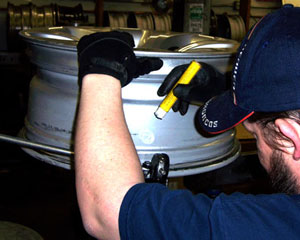 |
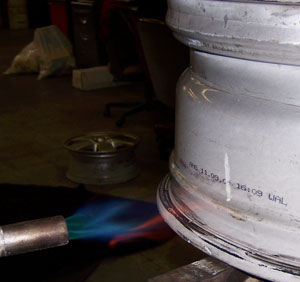 |
The wheel
is carefully heated with a torch. Heat softens the alloy, keeping
the wheel from cracking during the straightening process. Heat also
loosens what we refer to as the "crystalline structure"
of the alloy. Without loosening this structure and allowing it to
"heal" as it cools, the metal will retain a "memory"
of where it has been bent. Our process resets this memory and strengthens
the internal structure, or "temper" of the alloy. One of
the most important parts of our straighteners' training is learning
how to properly heat the wheel to perform our metallurgical magic. |
| Once the wheel is heated
properly, the bend can be straightened using hydraulic pressure and
custom-made tools. It requires not only skill and knowledge to straighten,
but also a "feel" for the metal, whether it is soft or brittle,
that can only be acquired by experience, which is one reason that
our straighteners must be trained so thoroughly. This wheel is now
straight to within 1/32", less than the width of a human hair.
Can you tell from this picture where the bend was? |
 |
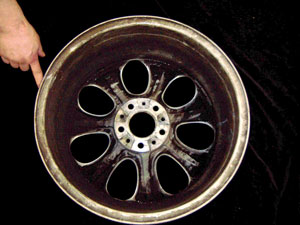 |
Even with
Sean pointing to the spot where the wheel was straightened, no bend
is visible. This wheel will now have a tire mounted onto it, and the
whole assembly will be balanced on a high-speed balancer. It will
then be installed back onto the car for another satisfied
customer! |
|
|

